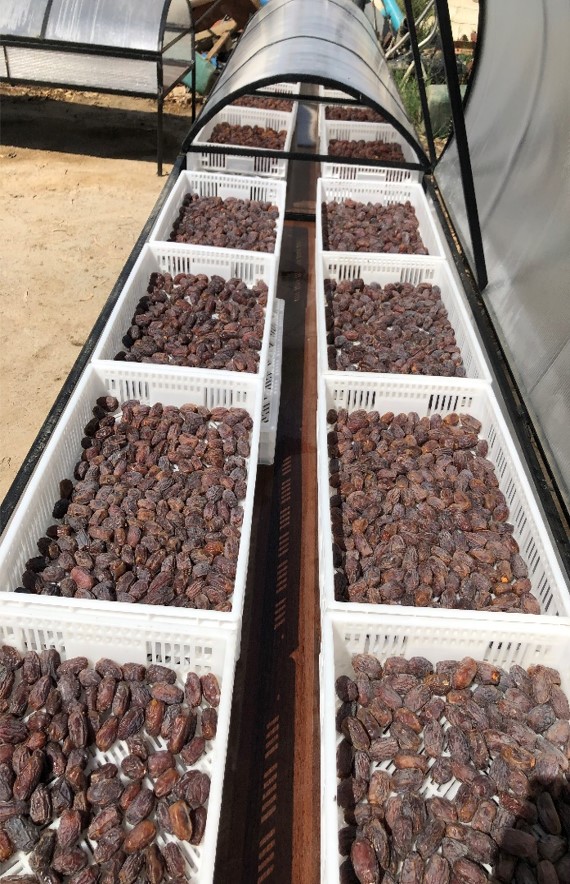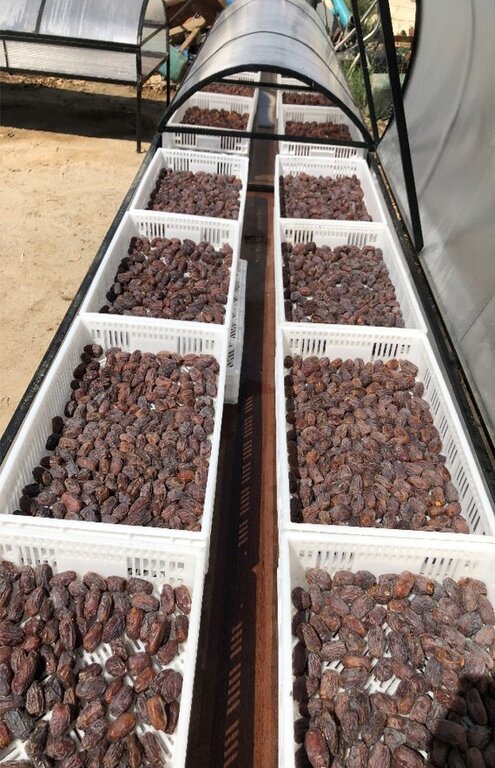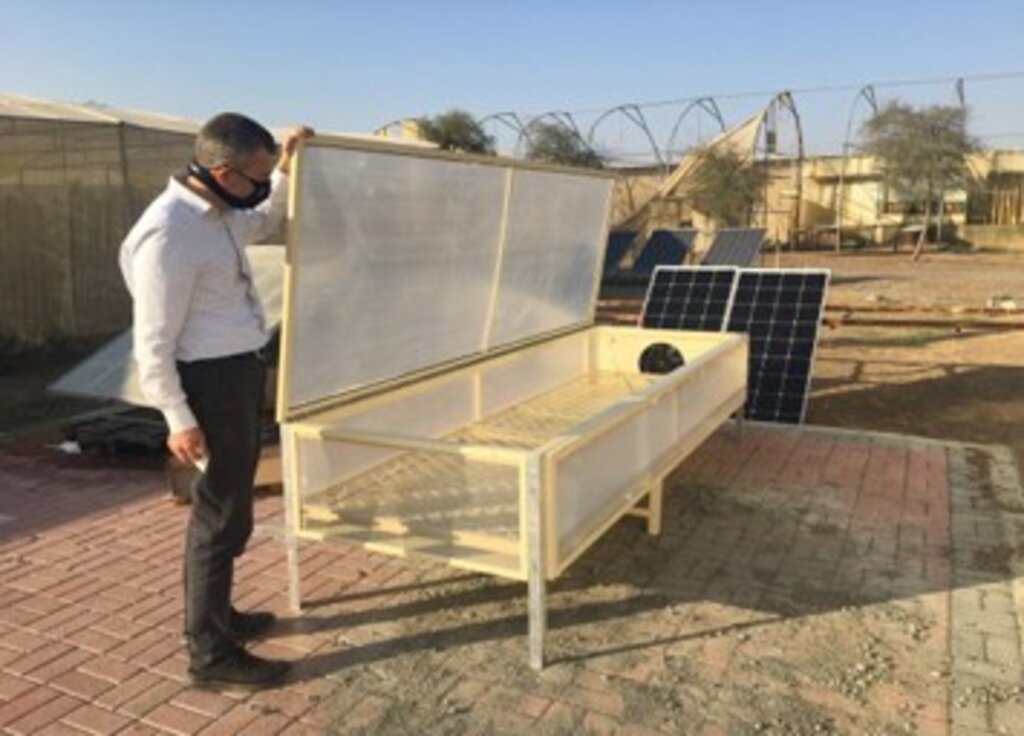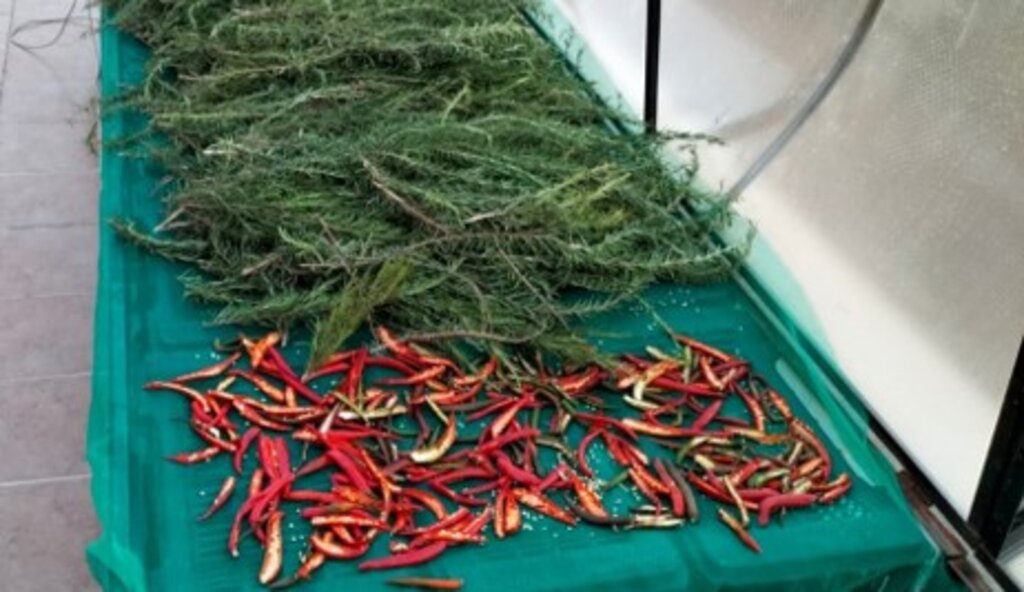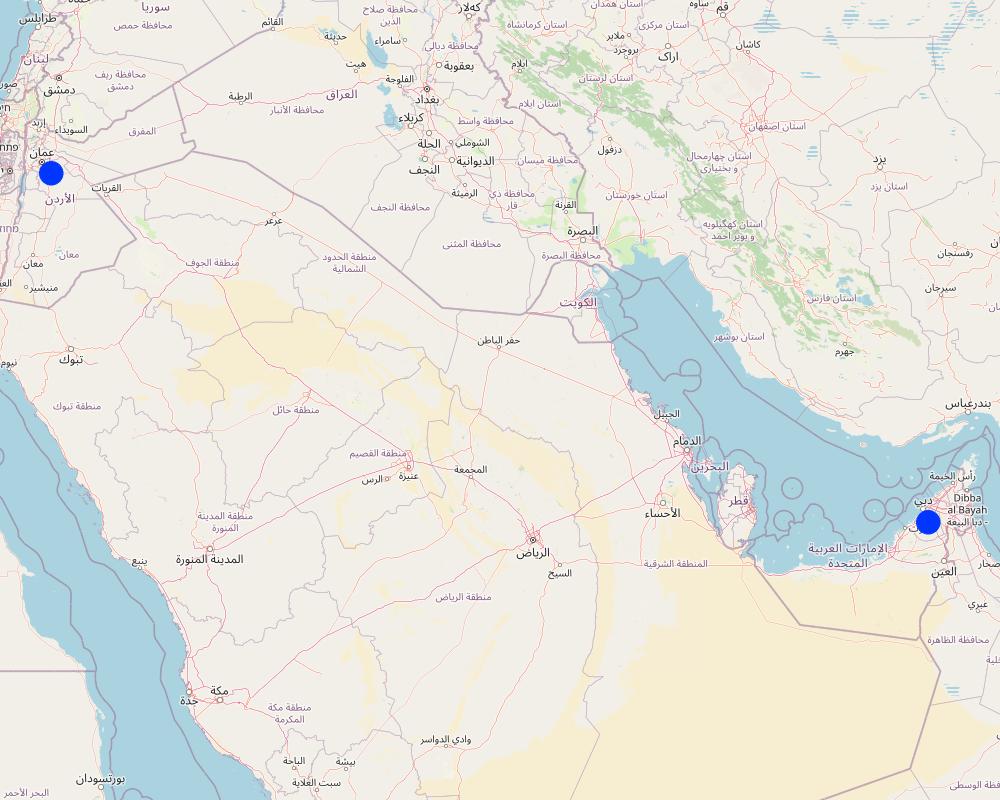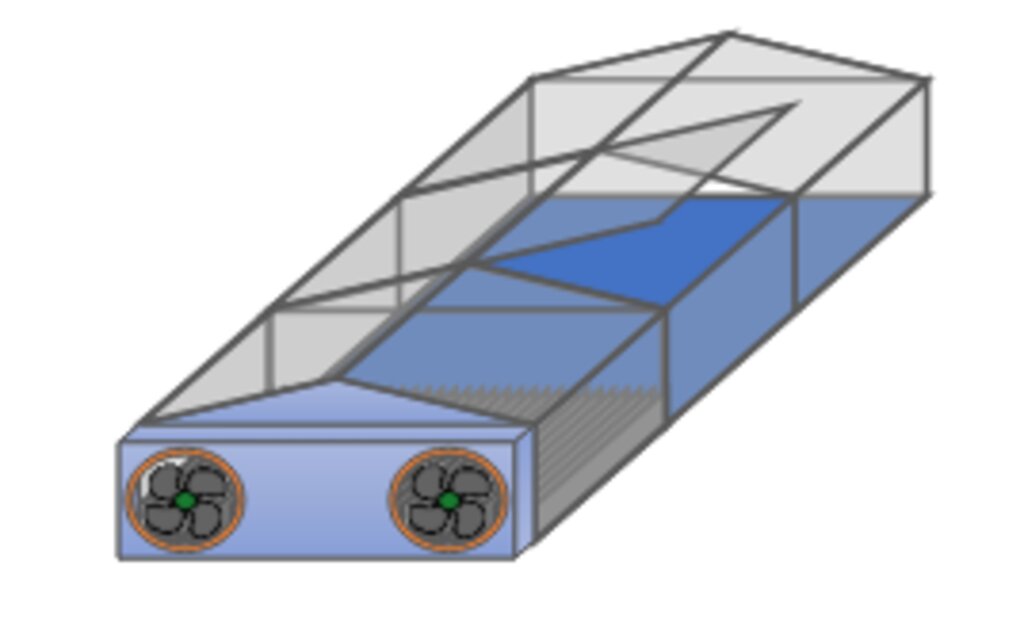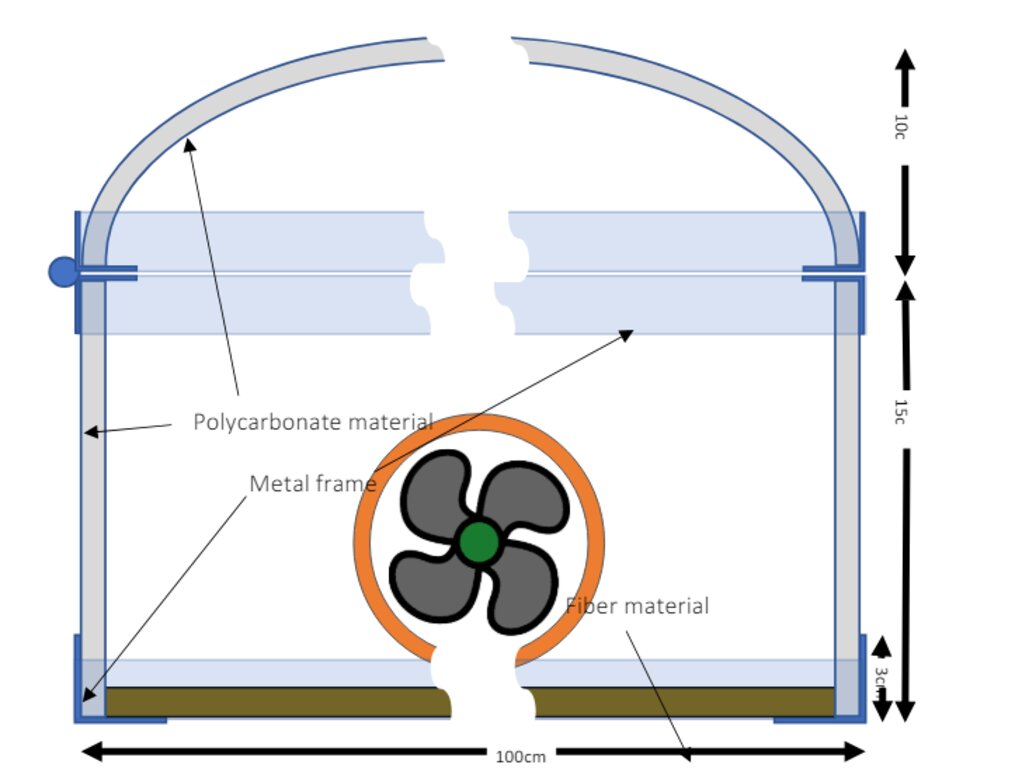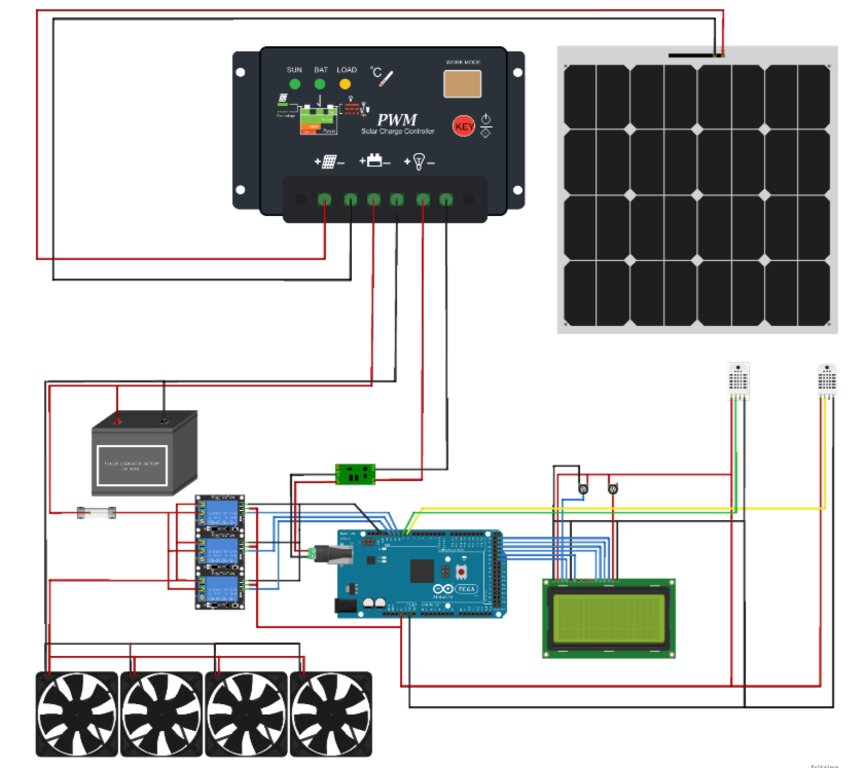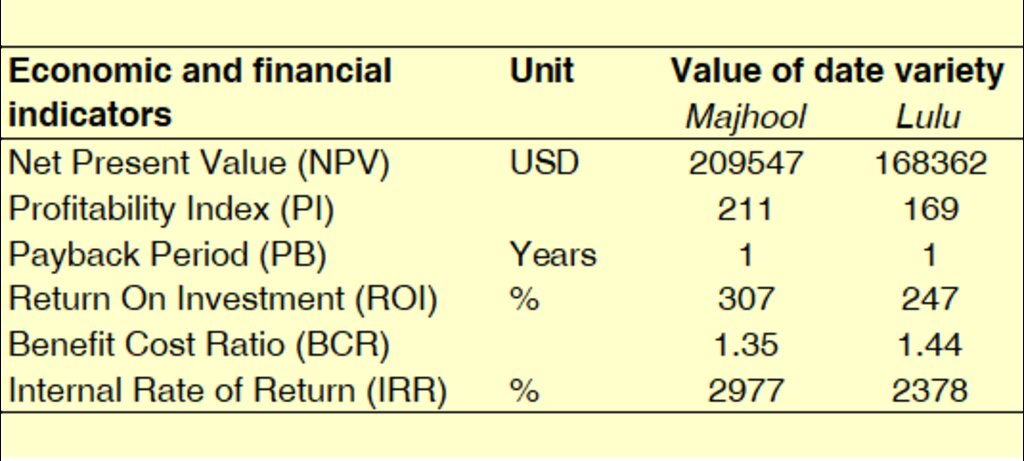Solar Mobile Dryer (SMD) [Emirados Árabes Unidos]
- Criação:
- Atualização:
- Compilador/a: Joren Verbist
- Editor: –
- Revisores: William Critchley, Rima Mekdaschi Studer
technologies_7197 - Emirados Árabes Unidos
Veja as seções
Expandir tudo Recolher tudo1. Informação geral
1.2 Detalhes do contato das pessoas capacitadas e instituições envolvidas na avaliação e documentação da tecnologia
Pessoa(s) capacitada(s)
Principal Natural Resources Economist:
Dhebibi Boubaker
International Center of Agriculture Research in the Dry Areas (ICARDA)
Tunísia
Food and Feed Processing Scientist:
Hilali Muhi El-Dine
International Center of Agriculture Research in the Dry Areas (ICARDA)
Jordânia
Activities Coordinator Officer:
Nejatian Arash
International Center of Agriculture Research in the Dry Areas (ICARDA)
Emirados Árabes Unidos
Regional Coordinator APRP:
Niane Abdoul Aziz
International Center of Agriculture Research in the Dry Areas (ICARDA)
Emirados Árabes Unidos
Nome do projeto que facilitou a documentação/avaliação da Tecnologia (se relevante)
ICARDA Institutional Knowledge Management InitiativeNome da(s) instituição(ões) que facilitou(ram) a documentação/ avaliação da Tecnologia (se relevante)
International Center for Agricultural Research in the Dry Areas (ICARDA) - Líbano1.3 Condições em relação ao uso da informação documentada através de WOCAT
O/a compilador/a e a(s) pessoa(s) capacitada(s) aceitam as condições relativas ao uso de dados documentados através da WOCAT:
Sim
1.4 Declaração de sustentabilidade da tecnologia descrita
A tecnologia descrita aqui é problemática em relação a degradação da terra de forma que não pode ser declarada uma tecnologia de gestão sustentável de terra?
Não
2. Descrição da tecnologia de GST
2.1 Descrição curta da tecnologia
Definição da tecnologia:
The innovative Solar Mobile Dryer (SMD) developed by ICARDA addresses climate change challenges for date palm growers in the Gulf Cooperation Council (GCC) countries by improving fruit quality, reducing waste, saving energy, and enhancing profitability, thereby supporting sustainable and efficient agricultural practices.
2.2 Descrição detalhada da tecnologia
Descrição:
In the Middle East, the date palm is an essential crop with significant cultural and economic value, thriving in dry, arid, and hot climates. However, climate change is exacerbating production challenges, with higher temperatures, heatwaves, water scarcity, harsh winds, leading to poor pollination, and increased pests amongst other issues. Small-scale date palm producers in the Gulf Cooperation Council (GCC) countries face additional problems of managing unsold or excess produce. Short harvesting periods and high deterioration rates of some date varieties make the situation worse. A common solution to extend shelf life is freezing. However, this has several drawbacks including storage and handling difficulties, nutrient and flavour degradation, and high energy costs.
To tackle these post-harvest challenges, the International Center of Agricultural Research in Dry Areas (ICARDA) developed an innovative Solar Mobile Dryer (SMB) for drying dates, achieving the desired colour for marketing while shielding the produce from dust and rain. The mobile solar dryer includes tables with polycarbonate covers forming a tunnel. Each table is 3 meters long, 1 meter wide, with walls 15-30 cm high, and raised 40 cm off the ground on metal legs. Dates are placed on a mesh for enhanced air flow and drying. Temperatures are kept at 70 degrees Celsius, the same as industrial date drying, to avoid textural changes, hardness, and colour alteration. Two versions of the tables have been produced.
The Jordan version, uses an iron frame and includes four tables that can form a 12-meter tunnel. This dryer has a 12V 40W DC fan, with a control unit and solar panel system, providing 6 hours of operation during the day and 2 hours at night, controlled by a temperature sensor.
The second version was developed in United Arab Emirates (UAE) and features a lighter aluminium frame and a 12V 80W fan fixed on one table. It includes temperature and humidity sensors, two solar panels, and a 20A charging controller.
The advantage and disadvantages of the SMB are as follows:
Advantages:
+ Improves fruit quality, especially in humid areas. Produce dried in greenhouses are often higher quality than those sun-dried.
+ Prevents contamination by insects, birds, dust, and rain.
+ Saves energy and drying time, improves product quality, and increases process efficiency.
+ Solar drying systems have low operation and maintenance costs.
+ Reduces waste and loss rates.
+ Reduces air pollution and greenhouse gases from fossil fuels.
+ Can be used for other products (e.g., fruits, vegetables, medicinal, and aromatic plants).
Disadvantages:
- Drying is limited to sunny days unless integrated with conventional energy systems. Drying without sunshine depends on the humidity difference between inside and outside the chamber.
- Solar drying is slower than conventional fuel or electricity-based dryers.
- Requires large land areas and long drying times, subject to solar radiation and temperature fluctuations.
- Farmers may lack maintenance knowledge for the system.
Economic evaluations of the SMD for two date varieties, Majhool and Lulu, demonstrate high profitability. The initial investment in the SMD is approximately 1,000 USD, with an estimated lifetime of about 10 years. The drying process takes between 1 and 3 days. The SMD has a capacity to dry between 6 and 12 kilograms of dates per square meter of drying surface in the SMD, resulting in production of around 5-10 kilograms of dried dates. Maintenance costs are estimated at 25% of the initial investment, while variable costs such as labour, packaging, and transportation are around 500 USD per month. Based on these figures, the net income per kilogram of dried dates is approximately 2.7 USD. Depending on the date variety, the return-on-investment ranges between 240% and 310%, with a payback period of about 4 months. These numbers indicate that the innovation is highly profitable for farmers.
The SMD is a crucial ICARDA initiative for smallholder date palm growers in the GCC countries, offering energy savings, waste reduction, and post-harvest loss prevention, enhancing the competitiveness of modern agriculture in high date production areas.
We express our sincere gratitude to the Gulf Cooperation Council (GCC) Secretariat for funding this research under the "Development of sustainable date palm production systems in the GCC countries of the Arabian Peninsula" project. We are grateful to the Ministries of Agriculture, Agricultural Authorities, and Agricultural Research Institutions and Universities in the GCC countries for their continuous support and collaboration in implementing project activities.
2.3 Fotos da tecnologia
2.5 País/região/locais onde a tecnologia foi aplicada e que estão cobertos nesta avaliação
País:
Emirados Árabes Unidos
Especifique a difusão da tecnologia:
- Aplicado em pontos específicos/concentrado numa pequena área
O(s) local(is) tecnológico(s) está(ão) localizado(s) em uma área permanentemente protegida?
Não
Map
×2.6 Data da implementação
Indique o ano de implementação:
2020
2.7 Introdução da tecnologia
Especifique como a tecnologia foi introduzida:
- durante experiências/ pesquisa
- através de projetos/intervenções externas
3. Classificação da tecnologia de GST
3.1 Principal/principais finalidade(s) da tecnologia
- Melhora a produção
- Adaptar a mudanças climáticas/extremos e seus impactos
- Atenuar a mudanças climáticas e seus impactos
- Criar impacto econômico benéfico
- Cria impacto social benéfico
3.2 Tipo(s) atualizado(s) de uso da terra onde a tecnologia foi aplicada
Uso do solo misturado dentro da mesma unidade de terra:
Não

Terra de cultivo
- Cultura de árvores e arbustos
Cultivo de árvores e arbustos - Especificar culturas:
- datas
Número de estações de cultivo por ano:
- 1
3.3 O uso do solo mudou devido à implementação da Tecnologia?
O uso do solo mudou devido à implementação da Tecnologia?
- Não (Continuar com a pergunta 3.4)
3.4 Abastecimento de água
Abastecimento de água para a terra na qual a tecnologia é aplicada:
- Misto de precipitação natural-irrigado
3.5 Grupo de GST ao qual pertence a tecnologia
- Medidas pós-colheita
3.6 Medidas de GST contendo a tecnologia

Outras medidas
Especifique:
This is a post-harvest and technological innovation.
3.7 Principais tipos de degradação da terra abordados pela tecnologia

Degradação biológica
- Bq: quantidade/ declínio da biomassa
3.8 Redução, prevenção ou recuperação da degradação do solo
Especifique o objetivo da tecnologia em relação a degradação da terra:
- Prevenir degradação do solo
- Reduzir a degradação do solo
Comentários:
This innovation increases the income of the farmers per unit area i.e., increased economic land productivity. This allows farmers to reduce pressure on the land and/or to manage their land more sustainable.
4. Especificações técnicas, implementação de atividades, entradas e custos
4.1 Desenho técnico da tecnologia
Especificações técnicas (relacionada ao desenho técnico):
Schematic view of the SMD
Fans blow air to control humidly and temperature. Top windows can be open to store and collect dates, but also for manual control of temperature etc.
Autor:
ICARDA
Data:
2022
Especificações técnicas (relacionada ao desenho técnico):
Side view dimensions of the SMD.
Plastic (poly-carbonate) sheets are held up by an iron frame. The product lay on a plastic net to also support vertical airflow.
Autor:
ICARDA
Data:
2022
Especificações técnicas (relacionada ao desenho técnico):
Technical schematic overview of the SMD
Autor:
ICARDA
Data:
2022
Especificações técnicas (relacionada ao desenho técnico):
Electronic parts and connections overview of the SMD
Drawn using Fritzing software, www.fritzing .org
Autor:
ICARDA
Data:
2022
Especificações técnicas (relacionada ao desenho técnico):
Net Present Value (NPV)
NPV evaluates an investment's profitability by calculating the difference between the present value of cash inflows and outflows. A positive NPV indicates a profitable investment, while a negative NPV signals a potential loss.
Profitability Index (PI)
PI measures the relative profitability of an investment by comparing the present value of future cash inflows to the initial investment. A PI greater than 1 indicates a good investment, whereas a PI less than 1 suggests it may not be viable.
Payback Period (PB)
PB is the time it takes for an investment to recover its initial cost through cash inflows. A shorter PB is preferred as it indicates quicker recovery, though it doesn't account for the time value of money or cash flows after the payback period but provides implication for risk.
Return on Investment (ROI)
ROI assesses the efficiency or profitability of an investment by comparing the net gain to the cost. A higher ROI indicates a more profitable investment.
Benefit-Cost Ratio (BCR)
BCR evaluates the value for money of a project by comparing the present value of benefits to costs. A BCR greater than 1 suggests benefits exceed costs, making the project worthwhile, while a BCR less than 1 indicates the opposite.
Internal Rate of Return (IRR)
IRR is the discount rate at which the NPV of all cash flows from an investment equals zero. If IRR exceeds the required rate of return, the investment is considered good. It's useful for comparing projects.
Autor:
ICARDA
Data:
2022
Especificações técnicas (relacionada ao desenho técnico):
Schematic drwing of the SMD as used in Jordan
Autor:
ICARDA
Data:
2024
4.2 Informação geral em relação ao cálculo de entradas e custos
Especifique como custos e entradas foram calculados:
- Por unidade de tecnologia
Especifique a moeda utilizada para os cálculos de custo:
- USD
4.4 Custos e entradas necessárias para a implantação
| Especifique a entrada | Unidade | Quantidade | Custos por unidade | Custos totais por entrada | % dos custos arcados pelos usuários da terra | |
|---|---|---|---|---|---|---|
| Equipamento | Charger control 1 (off grid, 12v 20A) | 1,0 | ||||
| Equipamento | Fuse (10A) | 2,0 | ||||
| Equipamento | Switch (10A) | 2,0 | ||||
| Equipamento | DC relay (16A) | 1,0 | ||||
| Equipamento | Sensors (temperature and humidity) | 1,0 | ||||
| Equipamento | Arduino micro processor | |||||
| Equipamento | LCD screen (2x20) | 1,0 | ||||
| Equipamento | DC relay (4 relay module) | 1,0 | ||||
| Material de construção | Polycarbonate board (8-10mm) | 2,0 | ||||
| Material de construção | Dark fiber board (6mm) | 2,0 | ||||
| Material de construção | Metal bars (3cm x 3cm x 10mm) | 20,0 | ||||
| Material de construção | Metal bars (2m x 2m) | 10,0 | ||||
| Material de construção | Metal hinges (small, <10mm) | 8,0 | ||||
| Material de construção | Fan (12v 40-80W) | 1,0 | ||||
| Material de construção | Battery (12v 55A) | 1,0 | ||||
| Material de construção | Solar panel (170W 12v) | 2,0 | ||||
| Outros | Voltage regulator (1-40v) | 1,0 | ||||
| Outros | Plastic terminal box (30cm x 40cm) | 1,0 | ||||
| Outros | Clock module (5v) | 1,0 | ||||
| Outros | SD card module (5v) | 1,0 | ||||
| Outros | BCP board | 2,0 | ||||
| Outros | Total costs | 1,0 | 1000,0 | 1000,0 | ||
| Custos totais para a implantação da tecnologia | 1000,0 | |||||
| Custos totais para o estabelecimento da Tecnologia em USD | 1000,0 | |||||
Se você não conseguir discriminar os custos na tabela acima, forneça uma estimativa dos custos totais para estabelecer a Tecnologia:
1000,0
4.6 Custos e entradas necessárias pata a manutenção/atividades recorrentes (por ano)
| Especifique a entrada | Unidade | Quantidade | Custos por unidade | Custos totais por entrada | % dos custos arcados pelos usuários da terra | |
|---|---|---|---|---|---|---|
| Outros | Maintenance | 1,0 | 250,0 | 250,0 | ||
| Outros | Variable (use) cost | 1,0 | 500,0 | 500,0 | ||
| Custos totais para a manutenção da tecnologia | 750,0 | |||||
| Custos totais de manutenção da Tecnologia em USD | 750,0 | |||||
4.7 Fatores mais importantes que afetam os custos
Descreva os fatores mais determinantes que afetam os custos:
Material costs for drying such as packaging appeared to be a major cost.
5. Ambiente natural e humano
5.1 Clima
Precipitação pluviométrica anual
- <250 mm
- 251-500 mm
- 501-750 mm
- 751-1.000 mm
- 1.001-1.500 mm
- 1.501-2.000 mm
- 2.001-3.000 mm
- 3.001-4.000 mm
- > 4.000 mm
Zona agroclimática
- Semiárido
- Árido
5.2 Topografia
Declividade média:
- Plano (0-2%)
- Suave ondulado (3-5%)
- Ondulado (6-10%)
- Moderadamente ondulado (11-15%)
- Forte ondulado (16-30%)
- Montanhoso (31-60%)
- Escarpado (>60%)
Formas de relevo:
- Planalto/planície
- Cumes
- Encosta de serra
- Encosta de morro
- Sopés
- Fundos de vale
Zona de altitude:
- 0-100 m s.n.m.
- 101-500 m s.n.m.
- 501-1.000 m s.n.m.
- 1.001-1.500 m s.n.m.
- 1.501-2.000 m s.n.m.
- 2.001-2.500 m s.n.m.
- 2.501-3.000 m s.n.m.
- 3.001-4.000 m s.n.m.
- > 4.000 m s.n.m.
Indique se a tecnologia é aplicada especificamente em:
- Não relevante
5.3 Solos
Profundidade do solo em média:
- Muito raso (0-20 cm)
- Raso (21-50 cm)
- Moderadamente profundo (51-80 cm)
- Profundo (81-120 cm)
- Muito profundo (>120 cm)
Textura do solo (solo superficial):
- Médio (limoso, siltoso)
Textura do solo (>20 cm abaixo da superfície):
- Médio (limoso, siltoso)
Matéria orgânica do solo superficial:
- Baixo (<1%)
5.4 Disponibilidade e qualidade de água
Lençol freático:
5-50 m
Disponibilidade de água de superfície:
Precário/nenhum
Qualidade da água (não tratada):
Água potável precária (tratamento necessário)
A qualidade da água refere-se a:
tanto de águas subterrâneas quanto de superfície
A salinidade da água é um problema?
Sim
Ocorre inundação da área?
Não
Comentários e outras especificações sobre a qualidade e a quantidade da água:
Because the SMD is mobile and processes the harvest, the natural situation is not that essential. However, ideally, it should be placed in warm and sunny areas.
5.5 Biodiversidade
Diversidade de espécies:
- Baixo
Diversidade de habitat:
- Baixo
5.6 Características dos usuários da terra que utilizam a tecnologia
Sedentário ou nômade:
- Sedentário
- Semi-nômade
Orientação de mercado do sistema de produção:
- misto (subsistência/comercial)
Rendimento não agrícola:
- 10-50% de toda renda
Nível relativo de riqueza:
- Pobre
Indivíduos ou grupos:
- Indivíduo/unidade familiar
- Grupos/comunidade
Nível de mecanização:
- Trabalho manual
- Mecanizado/motorizado
Gênero:
- Homens
Idade dos usuários da terra:
- Jovens
- meia-idade
- idosos
5.7 Área média de terrenos utilizados pelos usuários de terrenos que aplicam a Tecnologia
- < 0,5 ha
- 0,5-1 ha
- 1-2 ha
- 2-5 ha
- 5-15 ha
- 15-50 ha
- 50-100 ha
- 100-500 ha
- 500-1.000 ha
- 1.000-10.000 ha
- > 10.000 ha
É considerado pequena, média ou grande escala (referente ao contexto local)?
- Pequena escala
5.8 Propriedade de terra, direitos de uso da terra e de uso da água
Propriedade da terra:
- Indivíduo, não intitulado
- Indivíduo, intitulado
Direitos do uso da terra:
- Indivíduo
Direitos do uso da água:
- Indivíduo
Os direitos de uso da terra são baseados em um sistema jurídico tradicional?
Sim
5.9 Acesso a serviços e infraestrutura
Saúde:
- Pobre
- Moderado
- Bom
Educação:
- Pobre
- Moderado
- Bom
Assistência técnica:
- Pobre
- Moderado
- Bom
Emprego (p. ex. não agrícola):
- Pobre
- Moderado
- Bom
Mercados:
- Pobre
- Moderado
- Bom
Energia:
- Pobre
- Moderado
- Bom
Vias e transporte:
- Pobre
- Moderado
- Bom
Água potável e saneamento:
- Pobre
- Moderado
- Bom
Serviços financeiros:
- Pobre
- Moderado
- Bom
6. Impactos e declarações finais
6.1 Impactos no local mostrados pela tecnologia
Impactos socioeconômicos
Produção
Produção agrícola
Comentários/especificar:
(Economic) Productivity increases because post-harvest losses decrease and selling prices increase
Qualidade da safra
Comentários/especificar:
Because of the drying, products are considered higher quality
Renda e custos
Despesas com insumos agrícolas
Comentários/especificar:
To reach the higher selling prices additional expenses on the SMD and packaging is required.
Rendimento agrícola
Carga de trabalho
Impactos socioculturais
Segurança alimentar/auto-suficiência
Comentários/especificar:
Dried products have longer shelf life and less vulnerable to mold and pests.
Situação de grupos social e economicamente desfavorecidos
Comentários/especificar:
SMD is so designed that it can be easily shared, so that costs for individual smallholder farmers are relatively low.
6.2 Impactos externos mostrados pela tecnologia
Impacto dos gases de efeito estufa
Comentários/especificar:
The SMD only uses solar, so overall less greenhouse gasses are emitted, within the chain, compared to the current situation.
6.3 Exposição e sensibilidade da tecnologia às mudanças climáticas graduais e extremos/desastres relacionados ao clima (conforme o ponto de vista dos usuários da terra)
Mudança climática gradual
Mudança climática gradual
| Estação do ano | aumento ou diminuição | Como a tecnologia lida com isso? | |
|---|---|---|---|
| Temperatura anual | aumento | muito bem |
6.4 Análise do custo-benefício
Como os benefícios se comparam aos custos de implantação (do ponto de vista dos usuários da terra)?
Retornos a curto prazo:
levemente positivo
Retornos a longo prazo:
muito positivo
Como os benefícios se comparam aos custos recorrentes/de manutenção(do ponto de vista dos usuários da terra)?
Retornos a curto prazo:
muito positivo
Retornos a longo prazo:
muito positivo
6.5 Adoção da tecnologia
- casos isolados/experimental
De todos aqueles que adotaram a Tecnologia, quantos o fizeram espontaneamente, ou seja, sem receber nenhum incentivo/ pagamento material?
- 0-10%
6.6 Adaptação
A tecnologia foi recentemente modificada para adaptar-se as condições variáveis?
Sim
Outros (especificar):
other inputs
Especifique a adaptação da tecnologia (desenho, material/espécie, etc):
Experiments are done with other products such as vegetables, fruits, and spices.
6.7 Pontos fortes/vantagens/oportunidades da tecnologia
| Pontos fortes/vantagens/oportunidades na visão do usuário da terra |
|---|
| Increased farm income |
| Pontos fortes/vantagens/oportunidades na visão do/a compilador/a ou de outra pessoa capacitada |
|---|
| Improvement of the fruits’ quality |
| No contamination of dates by insects, birds, dust and rain |
| Energy and drying time saving |
| Waste and loss rate reduction |
| Air pollution and greenhouse gases reduction |
| Multiuse purposes (vegetables, medicinal and aromatic plants-MAPs, etc.) |
| Production of the SMD can result in (local) employment opportunities |
6.8 Pontos fracos, desvantagens/riscos da tecnologia e formas de superá-los
| Pontos fracos/vantagens/riscos na visão do/a compilador/a ou de outra pessoa capacitada | Como eles podem ser superados? |
|---|---|
| Drying can be performed only during sunny days unless the system is integrated with a conventional energy-based system | |
| Solar drying process is slow in comparison with dryers that use conventional fuels | The avoidance of costs to fuel may compensate this. |
| Solar drying requires larger land areas and longer drying times | |
| Fluctuations in solar radiation and ambient temperature | |
| Farmers lack of knowledge for the maintenance of the system | Capacity building programme or training when buying the SMD |
7. Referências e links
7.1 Métodos/fontes de informação
- entrevistas com especialistas em GST
- compilação de relatórios e outra documentação existente
7.3 Links para informações on-line relevantes
Título/ descrição:
Boubaker Dhehibi, Muhi El-Dine Hilali, Arash Nejatian. (15/9/2023). Economic and Financial Evaluation of a Low-Cost Portable Solar Dryer for Maturing and Drying of Dates: Business for Development (B4D) Report.
URL:
https://hdl.handle.net/20.500.11766/68749
Título/ descrição:
Muhi El-Dine Hilali, Arash Nejatian, Abdoul Aziz Niane, Mohamed Ali Bob. (30/11/2023). دليل تصنيع و تشغيل المجفف الشمسي المتنقل. Beirut, Lebanon: International Center for Agricultural Research in the Dry Areas (ICARDA).
URL:
https://hdl.handle.net/20.500.11766/69302
Título/ descrição:
Muhi El-Dine Hilali, Arash Nejatian. (28/3/2021). Developing solar drier for maturing and drying of dates in the Arabian Peninsula. Lebanon: International Center for Agricultural Research in the Dry Areas (ICARDA).
URL:
https://hdl.handle.net/20.500.11766/12826
Links e módulos
Expandir tudo Recolher tudoLinks
Não há links
Módulos
Não há módulos


